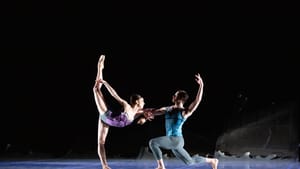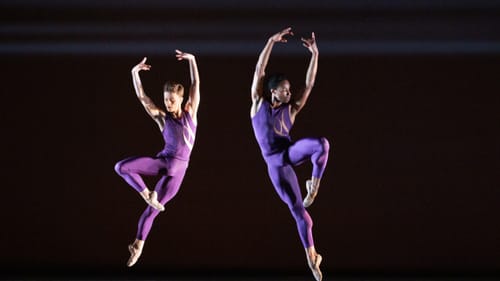Stay in the Loop
BSR publishes on a weekly schedule, with an email newsletter every Wednesday and Thursday morning. There’s no paywall, and subscribing is always free.
Trains, triggers, and Glass
The Pennsylvania Ballet presents its 2018-2019 season closer

Pennsylvania Ballet brought its season to an elegant close with works by three major choreographers, including two premieres. Each of these well-danced ballets incorporated color and interesting staging, making for a visually appealing program.
The first piece, Christopher Wheeldon’s DGV: Danse à Grande Vitesse, was inspired by the train à grande vitesse, or TGV, France’s high-speed rail. The second, Jorma Elo’s Trigger Touch Fade, was a world premiere, while the third, Jerome Robbins’s Glass Pieces, was a company premiere.
Trains—or not
Wheeldon created DGV in 2006 to commemorate the TGV, and the dance conveys momentum through its choreography, tempo, and formations. The opening image of a group of dimly lit, upright bodies rocking side to side suggested commuters on a train. The group’s form-fitting grey costumes, designed by Jean-Marc Puissant, could reflect machinery or steam, and some of Wheeldon’s choreography evoked chugging gears and spinning wheels. Dancers circled their arms as they formed two lines, like tracks for a train; in another section, they stepped deliberately to machine-like progress across the stage.
Because these hints were the extent of DGV’s TGV connection, the dance’s theme did not cohere. The set—also designed by Puissant—looked more like another planet than a train station, even a chic European one, as my guest pointed out. The shapeless black formations around which dancers moved could symbolize road, or rocks, or nothing at all. Meanwhile, duets performed by four couples wearing shades of blue, green, purple, and yellow did not seem related to a train.
Yet these sections were lovely to behold, full of gravity-defying lifts. In particular, Sterling Baca and retiring principal dancer Ian Hussey created the illusion of weightlessness with partners Dayesi Torriente and Yuka Iseda, who replaced Oksana Maslova in a last-minute casting change. Iseda’s and Torriente’s command of their bodies allowed them to bend into the shapes of swans and hold stiff as mannequins. Set to Michael Nyman’s MGV (Musique à Grande Vitesse), DGV was most compelling when the movement matched the tempo of the music.
Trigger Touch Fade

After a brief intermission, the company performed Trigger Touch Fade, an engaging premiere set to music by Bach and Haydn and featuring a violin solo by Luigi Mazzocchi. Lighting by Brad Fields created a distinct feel for each of the dance’s sections. In the first, beams of light crossed overhead to resemble the rafters of a barn; in another, low columns of light shot horizontally across the stage. Dancers wore costumes with filigree cutouts in colors more saturated than the hues of DGV, and these captured the vibrance of the dance. Highlights included Oksana Maslova and Zecheng Liang as the couple in red and the fast footwork of a group of male dancers in purple. Lillian DiPiazza and Baca, clad in sapphire blue, danced a harmonious duet.
A middle section incorporated elements that seemed out of place, such as kicky feet, twitchy knees, and jerky heads. Movement like this portrays a struggle for control, and it is more often found in contemporary dance. It seems to belong there, since ballet is about complete control and the appearance of effortless grace. Moreover, sometimes the convulsive-looking movements seemed to aim for humor, which also felt out of place in this otherwise elegant piece.
Honoring Philip Glass
The program concluded with another strong dance, which Robbins named in homage to Philip Glass’s music. Even though Glass Pieces was a premiere for the company, it is not a new dance: it debuted in 1983. Nevertheless, Robbins’s choreography was as fresh as the Pennsylvania Ballet’s performance. The curtain rose on a minimalist set, with four curtain prosceniums flanking a minimalist grid of a backdrop. “Looks like graph paper,” I heard someone say in the row behind me. Indeed, the classroom look matched the name Robbins gave to the first part of the dance: “Rubric.”
Inventive movement and staging made “Rubric” a standout. The corps de ballet walked across the stage, filling it with bodies and momentum. They all moved separately but in the same manner until one leaped up from the crowd. Then another body sprung into the air. The two leapers found one another and danced together. This pattern repeated with another couple, suggesting repetition with variation. This principle is a foundation of design, folklore, and other artistic modes, and it also lends itself to the rhythms of the school day and the academic year.

Maslova and Jermel Johnson paired in the middle section, “Facades,” as members of the corps moved in a line behind them. The two groups complemented each other thanks to Robbins’s careful attention to space and tempo. Because the dancers at the back of the stage moved slowly and rhythmically, sometimes resembling music-box ballerinas, they did not compete with the duet at the front of the stage. Toward the end, “Facades” began to seem a bit repetitive, but Maslova’s incredibly deep backbend kept it from wearing out its welcome. The final section, “Akhnaten (excerpt),” brought things back to life with beating drums and a lively trio embodying masculine energy. Toward the end, four lines of male and female dancers faced off before a strong finish with the dancers freezing in a tableau.
This final program of the PA Ballet season was a welcome breath of life and color offsetting the changeable skies and erratic temperatures of springtime in Philadelphia. Terrific music complemented the dancers’ success in maintaining ballet’s ultimate illusion: making the nearly impossible appear easy to execute.
What, When, Where
The Pennsylvania Ballet. Choreography by Christopher Wheeldon, Jorma Elo, and Jerome Robbins. May 9 through 12, 2019, at the Academy of Music, 240 S. Broad Street, Philadelphia. (215) 893-1999 or paballet.org.
The Academy of Music is an ADA-compliant venue.
Sign up for our newsletter
All of the week's new articles, all in one place. Sign up for the free weekly BSR newsletters, and don't miss a conversation.

 Melissa Strong
Melissa Strong